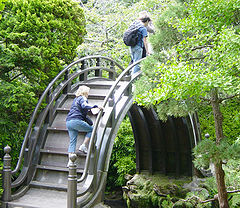- Moon bridge
-
Moon bridge 
A decorative bridge in the Japanese tea garden at Golden Gate Park in San Francisco, California. Although in the shape of an arch this wooden bridge is not technically a (compression) arch bridge, being rather a beam bridgeAncestor Arch bridge, Beam bridge Related None Descendant None Carries Pedestrians Span range short Material Stone, brick, wood, other materials Movable No Design effort low to medium Falsework required No A moon bridge is a highly arched pedestrian bridge, which in its wooden form may require the walker to initially climb (as one would a ladder) and also when descending. This type is associated with gardens in China and Japan. The moon bridge originated from China and was later introduced to Japan.[1][2]
This type of bridge was originally designed as a means to allow pedestrians to cross canals while allowing the passage of barges beneath. When constructed using the climbing ascent and descent this had the further advantage of not using space from the adjoining fields for approaches.
As part of formal garden design the bridge will be placed where its reflection is seen when the water is still. The half circle is intended to reflect in the calm water below the bridge, creating a full circle between bridge and reflection, a reference to the shape of the full moon.
When made from stone this becomes a true arch bridge, requiring stone approaches for structural stability. Chinese moon bridge at the Summer Palace, Beijing
See also
References
- ^ Boults, Elizabeth; Sullivan, Chip (2010). Illustrated history of landscape design. Hoboken, NJ: J. Wiley. p. 118. ISBN 9780470289334. http://books.google.com/books?id=zPo_rpsg4EEC.
- ^ Ono, Kenkichi; Edwards, Walter. "full-moon bridge 偃月橋・円月橋". Japanese Garden Dictionary: A Glossary for Japanese Gardens and Their History. http://www.nabunken.go.jp/database/jgd/pages/FullMoonBridge.html. Retrieved 2 September 2011.
Categories:- Deck arch bridges
- Pedestrian bridges
- Bridges
- Garden features
- Chinese gardening styles
- Japanese gardens
- Architecture stubs
- Bridge (structure) stubs
Wikimedia Foundation. 2010.

